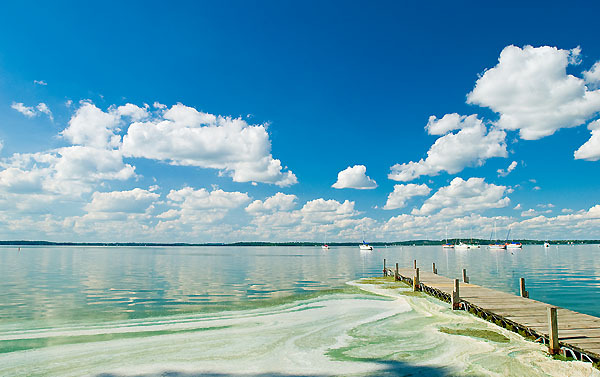New online tool puts Madison lakes on the map — and in the forecast
Imagine packing the car, herding your family on board and heading to the lake, only to find green, scummy water or a closed beach at your destination. Up until now, it’s been an all-too-common end to summer travel plans in Wisconsin. But a new online tool can send people to clearer waters.
Lakeforecast.org lets anyone with a smartphone or Internet access pull up a map of Madison’s Yahara chain of lakes and check out near real-time conditions at public beaches or out on the open water. Users can get information on water temperature and clarity, as well as updates on beach closures, algal blooms and even the presence of ducks and geese.
The project is the result of a collaboration between Clean Lakes Alliance (CLA), a Madison-based nonprofit focused on improving water quality in the Yahara watershed, Madison-based software company MIOsoft, the City of Madison, Dane County and the University of Wisconsin–Madison’s Center for Limnology (CFL) and Space Science and Engineering Center.
In all, lakeforecast.org provides information on 58 sites along the shores of the five Yahara lakes, as well as 25 city beaches. The massive dataset is the result of nearly four dozen volunteers, lakeshore homeowners and city lifeguards, the office of Public Health Madison & Dane County, and the constant stream of data being recorded by the Center for Limnology’s instrumented buoy in Lake Mendota.
That single buoy, says CFL director Steve Carpenter, played a key role in the website’s creation.
“There are a lot of people in Madison who already used our buoy feed, because we report things that boaters want to know, like water temperatures and wind speed, online. And people at the CLA had the idea, ‘Wouldn’t it be cool if we had a lake clarity report in there as well?'”
But getting at a measurement for clear water was more than just a matter of sending data to the CLA. There’s currently no instrument on the buoy to get a direct reading of water clarity. Instead, scientists were collecting data on things like chlorophyll and water chemistry. In the academic world, says Paul Hanson, a research professor at the Center for Limnology and partner in the lakeforecast.org project, that’s what traditionally gets measured. “But that doesn’t mean anything to the public,” he says. “What the public really wants to know is, ‘How clear is the water?'”
“What the public really wants to know is, ‘How clear is the water?’”
Paul Hanson
James Tye, executive director of Clean Lakes Alliance, agrees. He says the information provided on lakeforecast.org — like water clarity, temperature and beach closings — is the result of countless conversations with citizens. It’s the information boaters, swimmers and other lake users want to know. It makes sense, he says, for the land-grant university right on a lakeshore to help provide that information.
“Lake Mendota is widely regarded as the most studied lake in the world,” says Tye. “So why not get that work out to the general public? (The website) is taking the science that the UW does and weaving it into the popular culture.”
Tye’s hope is that lakeforecast.org can “serve up” the data that will elevate water quality and the state of Madison’s lakes in the public consciousness. For example, he’d love to see the lakes make more news.
“We have five lakes (in the Madison area) and you watch the news in the morning and they talk about the traffic, they talk about the pollen count, they talk about where the colors are on the leaves in the fall. But they don’t talk about what the water quality of the lakes is.”
Tye says he’d like to wake up every day to a report on water clarity and water temperature and beach conditions — everything someone would need to decide if it would be a good day to get out to the lake.
Lakeforecast.org provides information on 58 sites along the shores of the five Yahara lakes, as well as 25 city beaches.
Getting to that point is going to take some time, however. Not only do local TV stations need to add the lakes to their programming, but scientists have to figure out how to predict future lake conditions. Currently, lakeforecast.org reports observed conditions on the Yahara lakes. And sometimes it’s been a day or two since the last update.
“At some point down the road we are going to want to get into the business of actually forecasting water clarity,” says Hanson. “But that’s going to take the research effort of a graduate student who can really dig into the dynamic relationships of the system.”
It will also take more information, one reason the CLA and CFL recently collaborated with Dane County on plans to purchase a new buoy that will hopefully be anchored in Lake Monona, the lake just across the isthmus and downstream of Lake Mendota, sometime next year. The two organizations are currently raising funds to hire personnel to head up the buoy program, and maybe start on that research project for water quality forecasting.
“I can’t think of another example of continual water quality reporting of this nature,” says Hanson, “and I think globally, quite frankly, there’s tremendous interest in this. Over the next five years you’re going to see an explosion of this kind of activity, and it’s really cool to be at the leading edge of that.”
Subscribe to Wisconsin Ideas
Want more stories of the Wisconsin Idea in action? Sign-up for our monthly e-newsletter highlighting how Badgers are taking their education and research beyond the boundaries of the classroom to improve lives.


